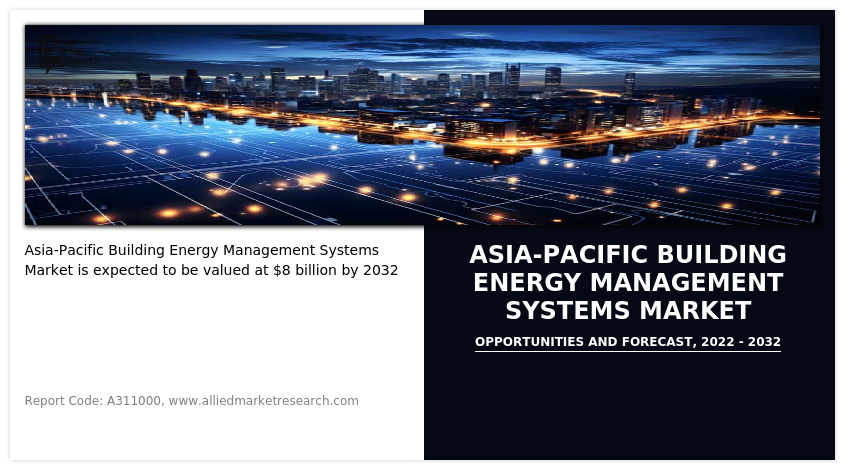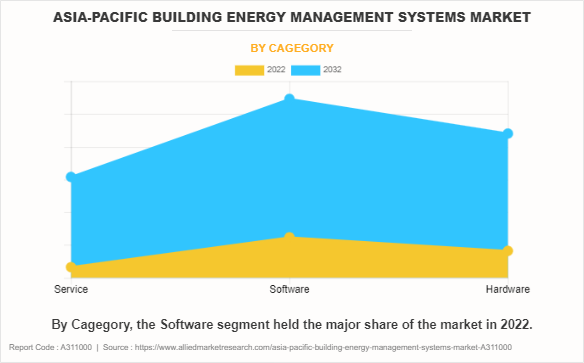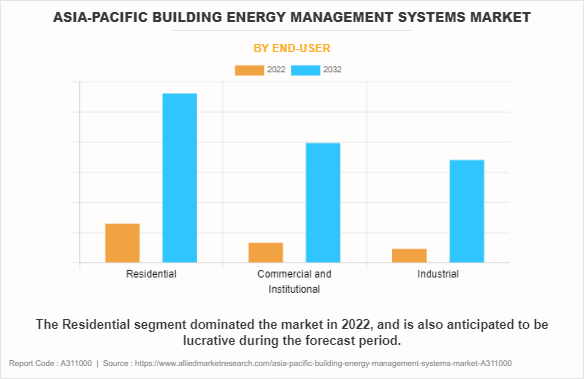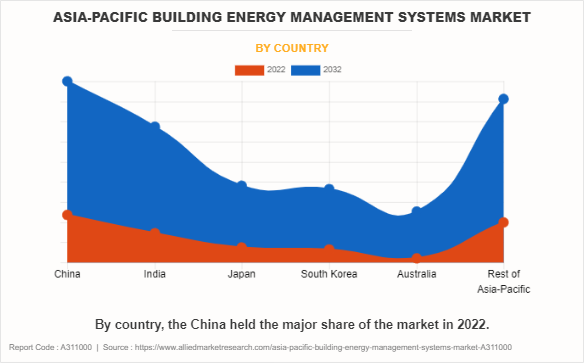The Asia-Pacific Building Energy Management Systems Market is expected to be valued at $8.0 billion by 2032.
Report Key Highlighters:
- The study integrated high-quality data, professional opinions and analysis, and critical independent perspectives. The research approach is intended to provide a balanced view of the Aisa-Pacific building energy management system market and to assist stakeholders in making educated decisions in order to achieve their most ambitious growth objectives.
- Over 3,700 product literature, annual reports, industry statements, and other comparable materials from major industry participants were reviewed to gain a better understanding of the market.
- The Asia-Pacific building energy management systems market share is highly fragmented, with several players including Johnson Controls, Delta Electronics, Mitsubishi Electric Corporation, Fuji Electric, Daikin Industries, Toshiba Corporation, Hitachi, Ltd., LG Electronics, Samsung Electronics, and Advantech Co., Ltd. Also tracked key strategies such as acquisitions, product launches, mergers, expansion etc. of the players operating in the Asia-Pacific building energy management systems market growth.

Asia-Pacific building energy management system is essentially a computer-based system that monitors and controls a building's electrical and mechanical equipment. It consists of a central controller, sensors, and communication devices that gather and analyze data. The central controller is the brain of the system, interpreting data from sensors and making adjustments to optimize energy usage. Sensors collect information on temperature, humidity, occupancy, and other relevant parameters. Communication devices enable seamless interaction between different components of the system, facilitating effective coordination and control.
In the commercial sector, including offices and retail spaces, BEMS helps maintain optimal working conditions while minimizing energy consumption. In the industrial sector, BEMS enhances the efficiency of manufacturing processes by regulating energy-intensive equipment. The healthcare industry benefits from BEMS by ensuring a comfortable and controlled environment for patients and staff. Educational institutions, residential buildings, and government facilities also deploy BEMS to reduce energy costs and contribute to environmental sustainability.
In industrial facilities, BEMS aids in optimizing the energy-intensive processes by providing insights into equipment performance and energy consumption patterns. This is crucial in regions like Asia-Pacific, where industrialization is a key driver of economic growth. By implementing BEMS, industries can enhance their energy efficiency, reduce operational costs, and comply with increasingly stringent environmental regulations.
Residential buildings in the Asia-Pacific region also benefit from BEMS, as it enables homeowners to monitor and manage their energy consumption. Smart home applications integrated with BEMS allow residents to control lighting, temperature, and other appliances remotely, contributing to both energy savings and convenience.
China, as the world's largest emitter of greenhouse gases, has been actively promoting energy efficiency and sustainability. The country has set ambitious targets to reduce carbon intensity and increase the share of non-fossil energy. BEMS adoption is gaining momentum, particularly in large cities such as Beijing and Shanghai, where rapid urbanization has led to increased demand for energy. The government's push for green buildings and smart cities further encourages the integration of BEMS to optimize energy usage in both residential and commercial structures.
Japan, with its advanced technology landscape, has been at the forefront of BEMS implementation. The country's focus on energy conservation and efficiency, especially after the Fukushima nuclear disaster, has accelerated the adoption of smart building solutions. BEMS is extensively used in commercial buildings, manufacturing plants, and residential complexes. Japan's commitment to achieving a carbon-neutral society by 2050 is likely to drive further advancements and innovations in BEMS technology.
India, experiencing rapid urbanization and industrial growth, faces significant energy challenges. BEMS is increasingly recognized as a solution to enhance energy efficiency in buildings. The government's initiatives, such as the Smart Cities Mission, emphasize the integration of smart technologies, including BEMS, to create sustainable urban spaces. In India, where a large population resides in urban areas, BEMS plays a crucial role in optimizing energy usage in commercial and residential buildings.
Innovations In IoT And cloud Computing Provide Lucrative Opportunities To The Market
Innovations in the Internet of Things (IoT) and cloud computing technologies have played a pivotal role in transforming the capabilities of Building Energy Management Systems (BEMS) across the Asia-Pacific region. The integration of IoT into BEMS has introduced a new paradigm where devices and sensors within buildings can communicate and share data seamlessly. This interconnectedness enables real-time monitoring and control of various energy-consuming systems, such as heating, ventilation, air conditioning (HVAC), lighting, and more.
The use of IoT in BEMS allows for the collection of vast amounts of data from different sensors and devices deployed throughout a building. This data is then processed and analyzed in the cloud, leveraging the power of advanced analytics and machine learning algorithms. As a result, BEMS can provide more granular insights into energy usage patterns, identify areas of inefficiency, and offer predictive maintenance capabilities. This data-driven approach enhances the overall efficiency of energy management strategies, contributing to significant energy savings for building owners and operators.
The high initial investment cost is expected to restrain the building energy management system market. The substantial upfront investment necessary for the implementation of Building Energy Management Systems (BEMS), encompassing hardware, software, and installation expenses, poses a significant restraint, particularly for smaller organizations. This financial barrier can impede the widespread adoption of BEMS, limiting its accessibility to businesses with constrained budgets. The need for a substantial capital outlay can discourage organizations, especially those operating on limited resources, from embracing BEMS solutions, hindering their ability to leverage the benefits of enhanced energy efficiency and sustainability offered by these systems.
The Asia-Pacific building energy management systems market is segmented into category, end-use industry, and region. On the basis of category, the market is classified into service, software, and hardware. On the basis of the end-use industry, the market is divided into residential, commercial & institutional, and industrial. In Asia-Pacific the market is studied across China, India, Japan, South Korea, Australia, and the rest of Asia-Pacific.

On the basis of category software segment dominated the Asia-Pacific building energy management systems market in 2022. BEMS in the Asia Pacific region is witnessing a trend towards integration with the Internet of Things (IoT) and other advanced technologies. This integration allows for a more comprehensive and interconnected approach to building management. IoT sensors and devices collect data in real-time, providing valuable insights that enable the BEMS to respond dynamically to changing conditions.

Based on end-use industry residential segment Asia-Pacific dominated the building energy management systems market in 2022. Residential buildings in the Asia Pacific face unique energy challenges due to diverse climatic conditions, cultural differences, and varying levels of technological infrastructure. Implementing energy management systems can address these challenges and contribute to a more sustainable and efficient energy future. Below are key aspects of the usage of building energy management systems in residential industries within the Asia Pacific region.

The Chinese government has been actively promoting energy efficiency and environmental sustainability. Various policies and initiatives have been implemented to encourage the adoption of energy management systems in buildings, further boosting the market. China has been at the forefront of smart city development, with a focus on integrating advanced technologies for efficient urban management. BEMS plays a crucial role in optimizing energy usage in smart buildings and contributing to the overall sustainability of smart cities.
The major players operating in the Asia-Pacific building energy management systems market analysis across Johnson Controls, Delta Electronics, Mitsubishi Electric Corporation, Fuji Electric, Daikin Industries, Toshiba Corporation, Hitachi, Ltd., LG Electronics, Samsung Electronics, and Advantech Co., Ltd.
Historic Trends Of Building Energy Management Systems Market
- In the early 2000s, several countries in the Asia-Pacific region began to explore and adopt building energy management systems to improve energy efficiency. Pilot projects and initiatives were launched in countries like Japan, South Korea, and Singapore.
- The 2010s saw a significant integration of building energy management systems with the broader smart building concept. Advanced analytics and cloud-based solutions emerged, allowing for remote monitoring and control of building systems. Governments in the region, such as China, promoted the use of BEMS through policies supporting green building initiatives.
- In 2015 BEMS adoption accelerated further, driven by a combination of environmental concerns, regulatory support, and cost-saving incentives. Some countries in the Asia-Pacific region established certification programs for energy-efficient buildings, boosting the demand for Asia-Pacific building energy management systems market trends.
Key Benefits For Stakeholders
- The report provides a comprehensive analysis of the current market estimations through 2022-2032, which would enable the stakeholders to capitalize on prevailing market opportunities.
- Major countries are mapped according to their revenue contribution to the asia-pacific building energy management systems market.
- In-depth analysis of the Asia-Pacific building energy management systems market forecast assists to determine the prevailing market opportunities.
- Identify key players and their strategic moves in Asia-Pacific building energy management systems market opportunities.
- Assess and rank the top factors that are expected to affect the growth of asia-pacific building energy management systems market.
- Analyze the market factors in various countries and understand business opportunities.
- Player positioning provides a clear understanding of the present position of key market players of Asia-Pacific building energy management systems market statistics.
Asia-Pacific Building Energy Management Systems Market Report Highlights
| Aspects | Details |
| Forecast period | 2022 - 2032 |
| Report Pages | 128 |
| By Cagegory |
|
| By End-User |
|
| By Country |
|
| Key Market Players | Emerson Electric Co., Trane Technologies plc, Rockwell Automation Inc., ABB Ltd., Delta Controls Inc., Mitsubishi Electric Corporation, Siemens AG, Johnson Controls International plc, Schneider Electric SE, Honeywell International Inc. |
The Asia-Pacific Building Energy Management Systems Market is estimated to reach $8 billion by 2032
Mitsubishi Electric Corporation, Schneider Electric SE, Honeywell International Inc., Johnson Controls International plc, Siemens AG, ABB Ltd., Delta Controls Inc., Trane Technologies plc, Emerson Electric Co., Rockwell Automation Inc. are the leading players in Asia-Pacific Building Energy Management Systems Market
1. The report provides a comprehensive analysis of the current market estimations through 2022-2032, which would enable the stakeholders to capitalize on prevailing market opportunities.
2. Major countries are mapped according to their revenue contribution to the asia-pacific building energy management systems market.
3. In-depth analysis of the asia-pacific building energy management systems market segmentation assists to determine the prevailing market opportunities.
4. Identify key players and their strategic moves in asia-pacific building energy management systems market.
5. Assess and rank the top factors that are expected to affect the growth of asia-pacific building energy management systems market.
6. Analyze the market factors in various countries and understand business opportunities. 7. Player positioning provides a clear understanding of the present position of key market players.
Asia-Pacific Building Energy Management Systems Market is classified as by cagegory, by end-user
Loading Table Of Content...
Loading Research Methodology...



